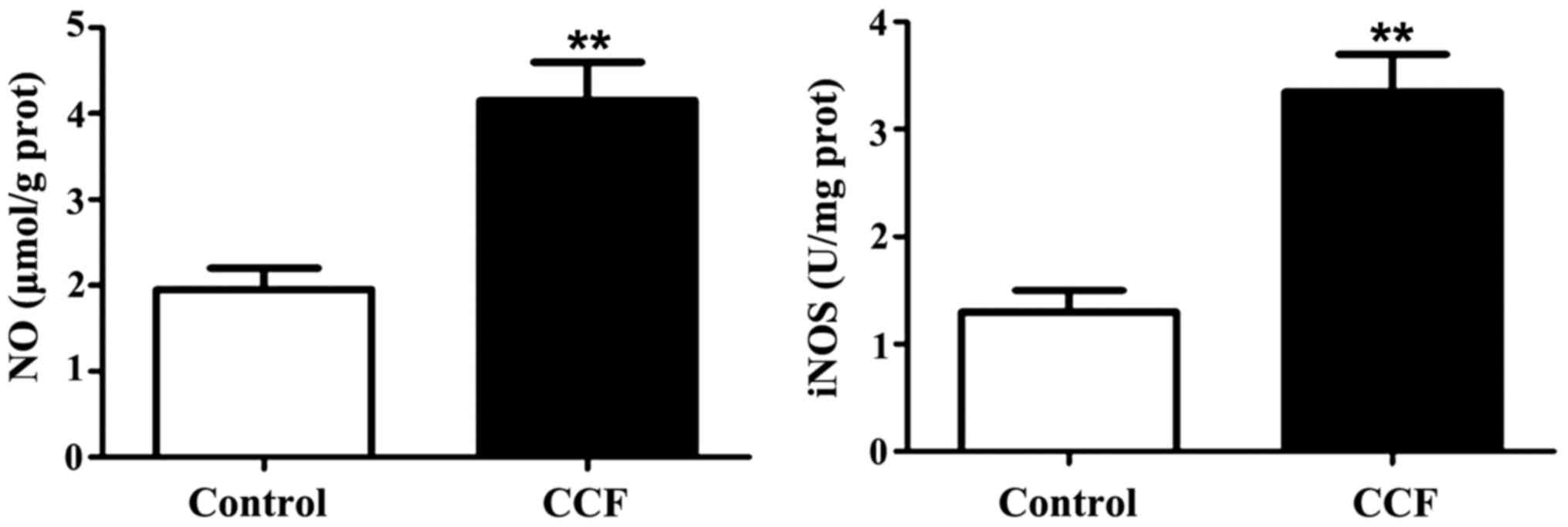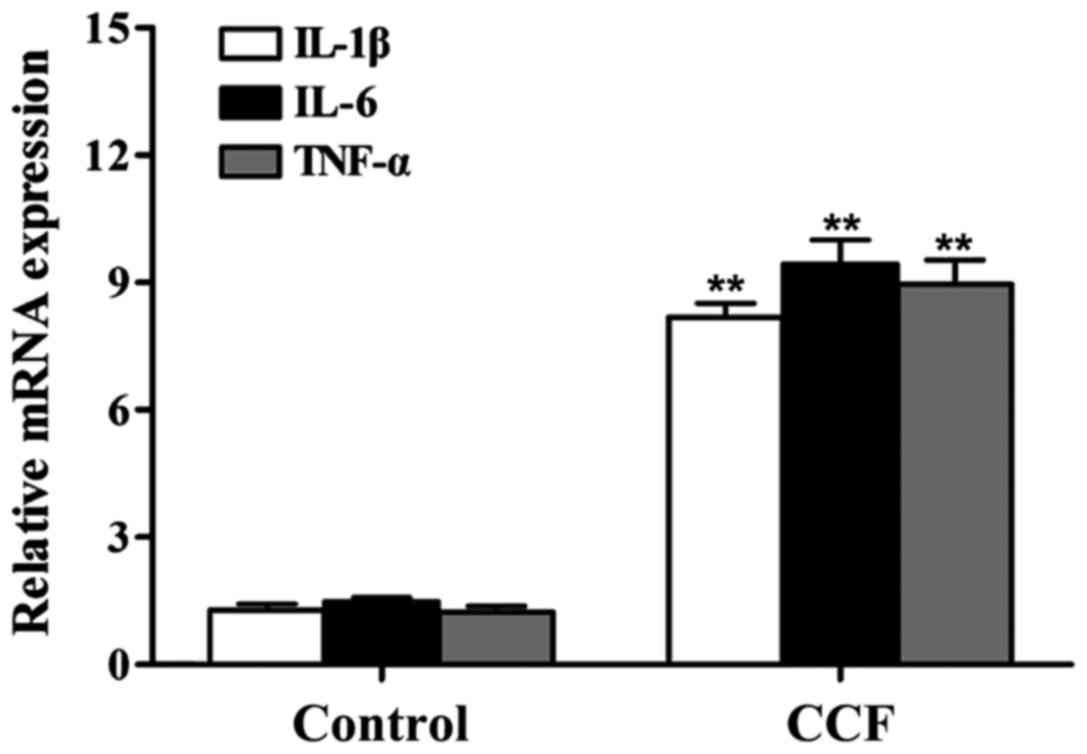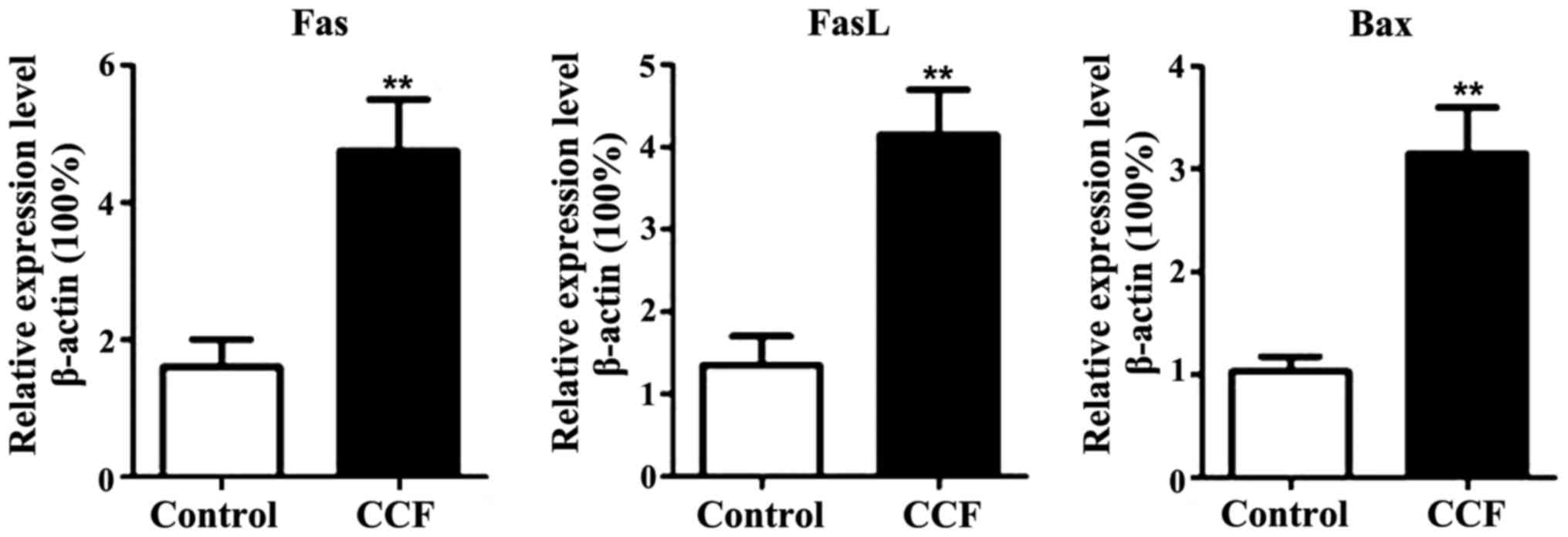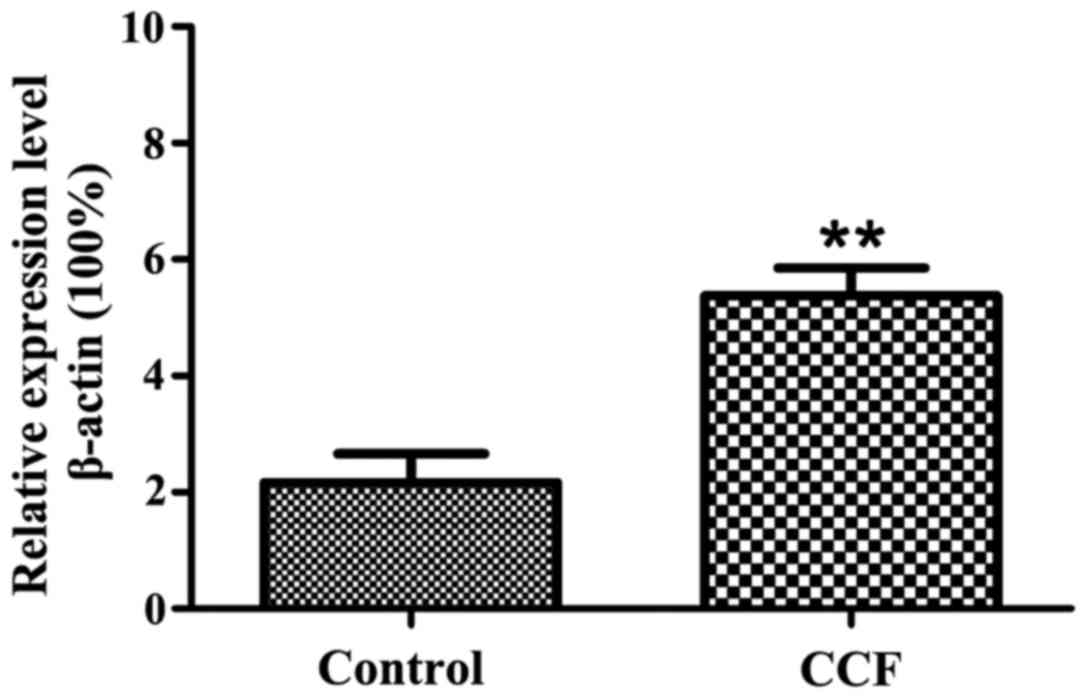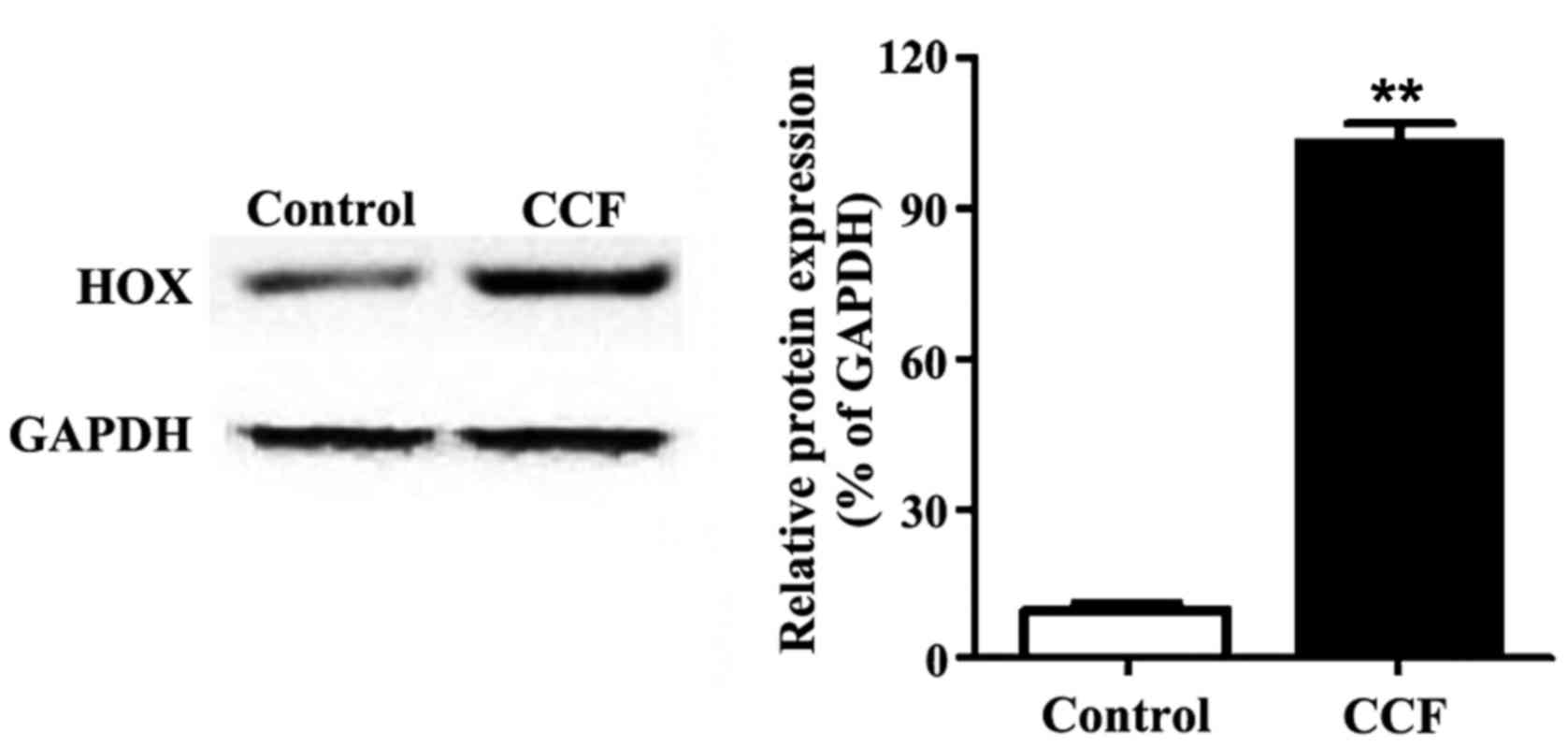Article
Open Access
Relationship between HOX gene and pediatric congenital clubfoot
- Authors:
-
View Affiliations / Copyright
Affiliations:
Department of the Bone and Joint Surgery, The Affiliated Hospital of Southwest Medical University, Luzhou, Sichuan 646000, P.R. China
-
Pages:
4861-4865
|
Published online on:
March 30, 2018
https://doi.org/10.3892/etm.2018.6013
- Expand metrics +
Metrics:
Total
Views: 0
(Spandidos Publications: | PMC Statistics:
)
Metrics:
Total PDF Downloads: 0
(Spandidos Publications: | PMC Statistics:
)
This article is mentioned in:
Abstract
The relationship between transcription factor homeobox gene (HOX gene) and pediatric congenital clubfoot (CCF) was studied. The CCF group comprised 35 cases of children, and the control group compised 34 cases of children without congenital malformation. The levels of inducible nitric oxide synthase (iNOS) and nitric oxide (NO) in the serum of the control and CCF groups were measured using iNOS and NO kits. Interleukin-1β (IL-1β), IL-6 and tumor necrosis factor-α (TNF-α) related to inflammation in the tissues of both groups were detected by reverse transcription‑polymerase chain reaction (RT-PCR). Fatty acid synthase (Fas), Fas ligand (FasL) and Bcl-2‑associated X (Bax) related to apoptosis as well as the expression of HOX mRNA, the expression of HOX in the control and CCF groups was detected by western blot analysis, and the differential expression of HOX in the control and CCF groups was statistically analyzed. Results of the kit detection showed that the expression of iNOS and NO in the CCF group were significantly higher than those in the control group, indicating that severe oxidative damage occurred in the CCF group. The results of detecting inflammatory factors and apoptosis by RT-PCR showed that the expression of IL-1β, IL-6, TNF-α, Fas, FasL and Bax mRNA in the CCF group was significantly higher than that in the control group, indicating pathogenesis of CCF was related to inflammation and apoptosis. RT-PCR and western blot analysis revealed HOX was highly expressed in the tissues of CCF, and the expression quantity was significantly stronger than that in the control group. The result of analysis of variance showed that the expression differences of HOX in normal and CCF tissues were statistically significant (P<0.01). Abnormal expression of HOX was closely related to the occurrence and development of CCF, indicating that HOX has important research value in CCF and this functional mechanism is related to oxidative damage, inflammation and apoptosis. Expression of HOX therefore shows promise as an indicator of CCF diagnosis and treatment.
View References
|
1
|
Ponseti IV: Treatment of congenital club
foot. J Bone Joint Surg Am. 74:448–454. 1992. View Article : Google Scholar : PubMed/NCBI
|
|
2
|
Dobbs MB and Gurnett CA: Update on
clubfoot: Etiology and treatment. Clin Orthop Relat Res.
467:1146–1153. 2009. View Article : Google Scholar : PubMed/NCBI
|
|
3
|
Stewart SF: Club-foot: Its incidence,
cause, and treatment; an anatomical-physiological study. J Bone
Joint Surg Am. 33-A:577–590. 1951. View Article : Google Scholar : PubMed/NCBI
|
|
4
|
Kite JH: Principles involved in the
treatment of congenital clubfoot. J Bone Joint Surg Am. 21:595–606.
1939.
|
|
5
|
Beeman RW, Stuart JJ, Haas MS and Denell
RE: Genetic analysis of the homeotic gene complex (HOM-C) in the
beetle Tribolium castaneum. Dev Biol. 133:196–209. 1989.
View Article : Google Scholar : PubMed/NCBI
|
|
6
|
Krumlauf R: Hox genes in vertebrate
development. Cell. 78:191–201. 1994. View Article : Google Scholar : PubMed/NCBI
|
|
7
|
Bienz M: Homeotic genes and positional
signalling in the Drosophila viscera. Trends Genet.
10:22–26. 1994. View Article : Google Scholar : PubMed/NCBI
|
|
8
|
Kite JH: The classic. Principles involved
in the treatment of congenital clubfoot by J. Hiram Kite, M.D.
reprinted from J. Bone Joint Surg. 21:595-606, 1939. Clin Orthop
Relat Res. 84:4–8. 1972.PubMed/NCBI
|
|
9
|
Ponseti IV: Common errors in the treatment
of congenital clubfoot. Int Orthop. 21:137–141. 1997. View Article : Google Scholar : PubMed/NCBI
|
|
10
|
Ponseti IV and Smoley EN: Congenital club
foot: The results of treatment. J Bone Joint Surg Am. 45:261–344.
1963. View Article : Google Scholar
|
|
11
|
Gerlach DJ, Gurnett CA, Limpaphayom N,
Alaee F, Zhang Z, Porter K, Kirchhofer M, Smyth MD and Dobbs MB:
Early results of the Ponseti method for the treatment of clubfoot
associated with myelomeningocele. J Bone Joint Surg Am.
91:1350–1359. 2009. View Article : Google Scholar : PubMed/NCBI
|
|
12
|
Pirani S, Zeznik L and Hodges D: Magnetic
resonance imaging study of the congenital clubfoot treated with the
Ponseti method. J Pediatr Orthop. 21:719–726. 2001. View Article : Google Scholar : PubMed/NCBI
|
|
13
|
Boehm S, Limpaphayom N, Alaee F, Sinclair
MF and Dobbs MB: Early results of the Ponseti method for the
treatment of clubfoot in distal arthrogryposis. J Bone Joint Surg
Am. 90:1501–1507. 2008. View Article : Google Scholar : PubMed/NCBI
|
|
14
|
Laaveg SJ and Ponseti IV: Long-term
results of treatment of congenital club foot. J Bone Joint Surg Am.
62:23–31. 1980. View Article : Google Scholar : PubMed/NCBI
|
|
15
|
Cummings RJ, Davidson RS, Armstrong PF and
Lehman WB: Congenital clubfoot. J Bone Joint Surg Am. 84-A:290–308.
2002. View Article : Google Scholar : PubMed/NCBI
|
|
16
|
Zákány J and Duboule D: Hox genes in digit
development and evolution. Cell Tissue Res. 296:19–25. 1999.
View Article : Google Scholar : PubMed/NCBI
|
|
17
|
Arenas-Mena C, Cameron AR and Davidson EH:
Spatial expression of Hox cluster genes in the ontogeny of a sea
urchin. Development. 127:4631–4643. 2000.PubMed/NCBI
|
|
18
|
Arenas-Mena C, Martinez P, Cameron RA and
Davidson EH: Expression of the Hox gene complex in the indirect
development of a sea urchin. Proc Natl Acad Sci USA.
95:13062–13067. 1998. View Article : Google Scholar : PubMed/NCBI
|
|
19
|
Finnerty JR, Pang K, Burton P, Paulson D
and Martindale MQ: Origins of bilateral symmetry: Hox and dpp
expression in a sea anemone. Science. 304:1335–1337. 2004.
View Article : Google Scholar : PubMed/NCBI
|
|
20
|
Castelli-Gair J and Akam M: How the Hox
gene Ultrabithorax specifies two different segments: The
significance of spatial and temporal regulation within metameres.
Development. 121:2973–2982. 1995.PubMed/NCBI
|















